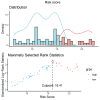Explainable machine learning algorithm to predict cardiovascular event in patients undergoing peritoneal dialysis
- PMID: 40264140
- PMCID: PMC12016290
- DOI: 10.1186/s12911-025-03003-w
Explainable machine learning algorithm to predict cardiovascular event in patients undergoing peritoneal dialysis
Abstract
Objective: To compare the performance of predictive models for cardiovascular event (CVE) in patients undergoing peritoneal dialysis (PD) based on machine learning algorithm and Cox proportional hazard regression.
Methods: This study included patients underwent PD catheterization in our center from January 1, 2010, to July 31, 2022. The patients were randomly divided into training and validation sets in a 7:3 ratio. Cox regression, extreme gradient boosting (XGBoost), and random survival forest (RSF) models were developed using the training set and validated using the validation set. The time-dependent area under the curve (AUC) and concordance index (C-index) were used to evaluate the discriminative ability of predictive models.
Results: A total of 318 patients were enrolled in this study. 110 (34.6%) patients developed CVE during the median follow-up of 31(16,56) months. The RSF model had better predictive performance, with a C-index of 0.725 and 1-, 3-, and 5-year time-dependent AUC of 0.812, 0.836, and 0.706 in the validation set, respectively. The top 5 important variables identified were platelet count, age, 4 hD/Pcr, left atrium diameter, and left ventricular diameter. Patients were classified into high-risk and low-risk groups based on the cut-off risk score calculated using the maximally selected rank statistics in the validation set. The log-rank test showed a significant difference in cumulative CVE-free survival probability between the two groups.
Conclusion: The RSF model may be a useful method for evaluating CVE risk in PD patients.
Keywords: Cardiovascular event; Machine learning; Peritoneal dialysis; Predictive model; Random survival forest.
© 2025. The Author(s).
Conflict of interest statement
Declarations. Ethics approval and consent to participate: This study was approved by the Ethics Committee of the Second Affiliated Hospital of Anhui Medical University. All participants provided signed written informed consent. Consent for publication: Not applicable. Competing interests: The authors declare no competing interests.
Figures






Similar articles
-
Construction of a random survival forest model based on a machine learning algorithm to predict early recurrence after hepatectomy for adult hepatocellular carcinoma.BMC Cancer. 2024 Dec 25;24(1):1575. doi: 10.1186/s12885-024-13366-4. BMC Cancer. 2024. PMID: 39722042 Free PMC article.
-
Risk prediction of cardiovascular events in peritoneal dialysis patients.BMC Nephrol. 2025 Apr 5;26(1):177. doi: 10.1186/s12882-025-04091-6. BMC Nephrol. 2025. PMID: 40188321 Free PMC article.
-
[Constructing a predictive model for the death risk of patients with septic shock based on supervised machine learning algorithms].Zhonghua Wei Zhong Bing Ji Jiu Yi Xue. 2024 Apr;36(4):345-352. doi: 10.3760/cma.j.cn121430-20230930-00832. Zhonghua Wei Zhong Bing Ji Jiu Yi Xue. 2024. PMID: 38813626 Chinese.
-
Can Predictive Modeling Tools Identify Patients at High Risk of Prolonged Opioid Use After ACL Reconstruction?Clin Orthop Relat Res. 2020 Jul;478(7):0-1618. doi: 10.1097/CORR.0000000000001251. Clin Orthop Relat Res. 2020. PMID: 32282466 Free PMC article.
-
Cardiac valve calcification as a predictor of cardiovascular outcomes in peritoneal dialysis patients: an inverse probability of treatment weighting analysis.Int Urol Nephrol. 2023 May;55(5):1271-1278. doi: 10.1007/s11255-022-03430-y. Epub 2022 Dec 1. Int Urol Nephrol. 2023. PMID: 36454448
References
-
- Krediet RT, Balafa O. Cardiovascular risk in the peritoneal dialysis patient. Nat Rev Nephrol. 2010;6(8):451–60. - PubMed
-
- Sarnak MJ, Amann K, Bangalore S, Cavalcante JL, Charytan DM, Craig JC, et al. Chronic Kidney Disease and Coronary Artery Disease: JACC State-of-the-Art Review. J Am Coll Cardiol 2019;74:1823–38. - PubMed
-
- D’Agostino Sr RB, Vasan RS, Pencina MJ, Wolf PA, Cobain M, Massaro JM, et al. General cardiovascular risk profile for use in primary care: the Framingham Heart Study. Circulation 2008;117:743–53. - PubMed
-
- Su PF, Lin CK, Hung JY, Lee JS. The Proper Use and Reporting of Survival Analysis and Cox Regression. World Neurosurg. 2022;161:303–09. - PubMed
MeSH terms
LinkOut - more resources
Full Text Sources

